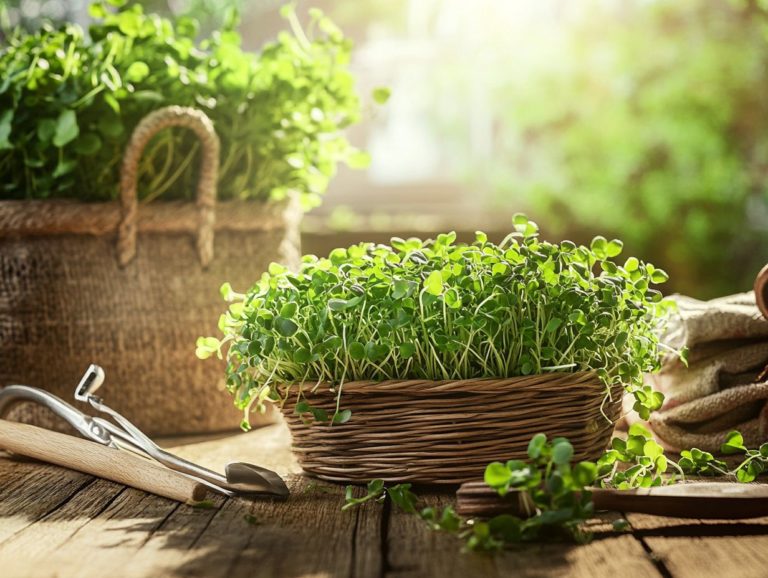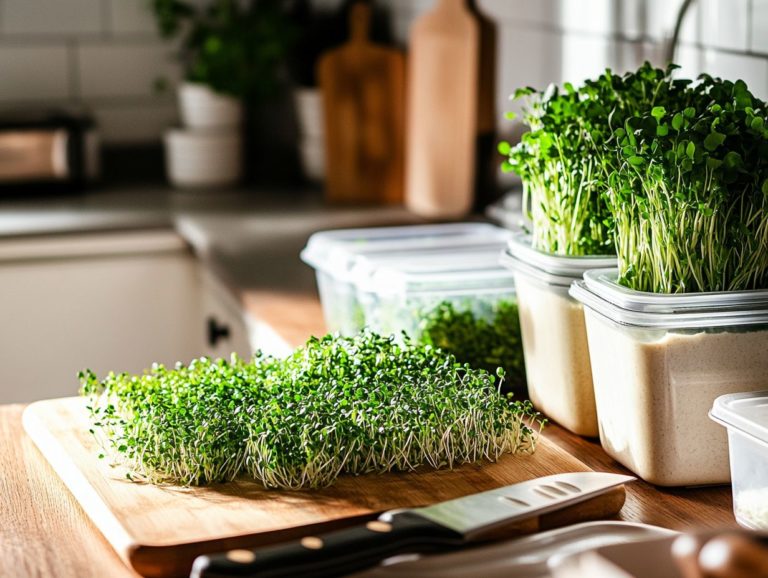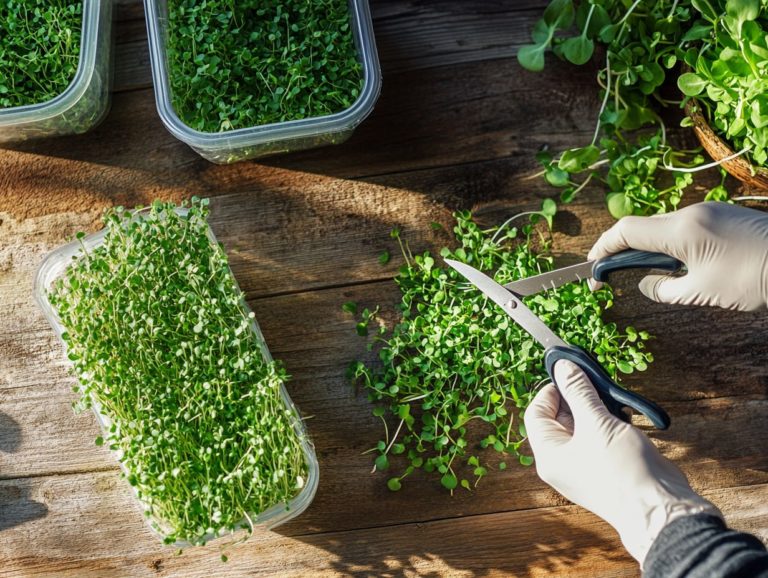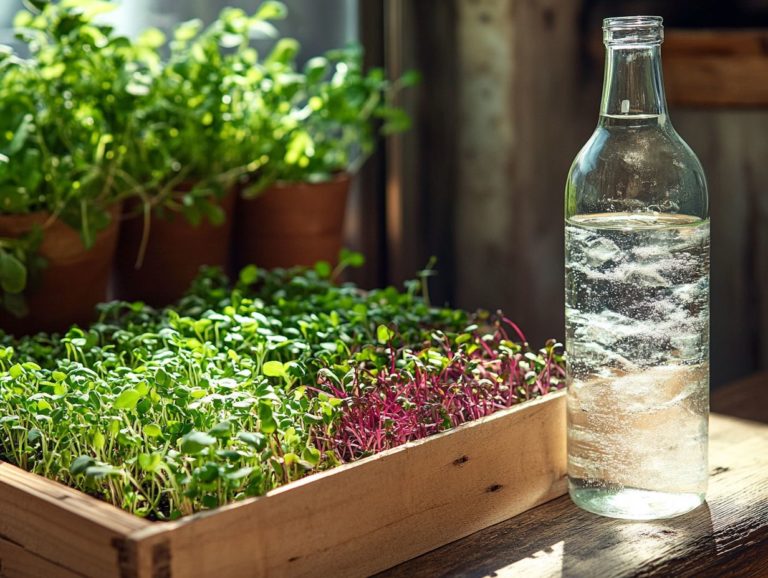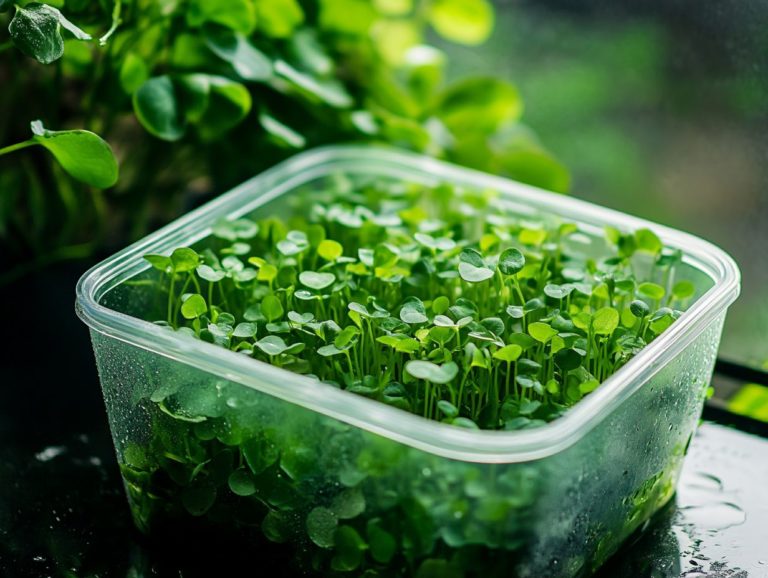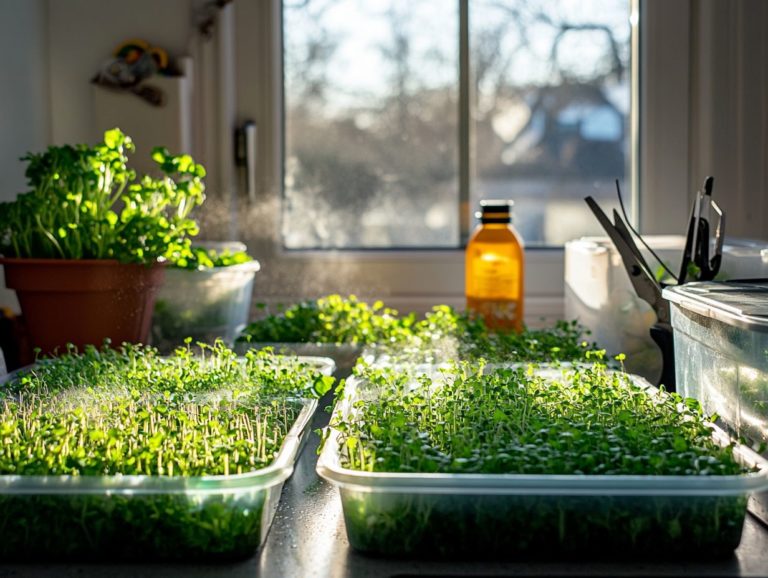How to Choose the Right Container for Microgreens
Microgreens are delightful, nutrient-dense plants that can elevate your meals and enhance your overall health. Their popularity is reflected in the diverse customer bases who frequent farmer’s markets and grocery stores.
Growing them at home isn t just a hobby; it s a rewarding journey that brings substantial nutritional benefits while saving you some cash.
Selecting the right container is essential for their thriving success. Understanding packaging considerations can greatly enhance your customer experience. Consider factors like size, material, drainage, and aeration, all of which play a pivotal role.
Let s explore the best container options for microgreens, including eco-friendly packaging choices, and offers invaluable tips for growing them successfully right in your own kitchen.
Contents
- Key Takeaways:
- Benefits of Growing Microgreens at Home
- Factors to Consider when Choosing a Container
- Types of Containers for Microgreens
- Best Practices for Growing Microgreens in Containers
- Preparing the Container
- Planting and Maintenance Tips
- Choosing the Right Container for Your Microgreens
- Frequently Asked Questions
- What factors should I consider when choosing a container for microgreens?
- What size container is best for growing microgreens?
- What materials are best for microgreen containers?
- Do I need special drainage holes in my container for microgreens?
- Do I need to provide ventilation for my microgreens?
- Can I reuse containers for growing microgreens?
Key Takeaways:
- Consider the size, material, drainage, and cost when choosing a container for microgreens.
- Use recycled containers or specialized microgreen containers, including clamshells, for cost-effective and efficient growth.
- Prepare the container properly and follow planting and maintenance tips for successful microgreen growth.
What are Microgreens?
Microgreens are young plants that you can harvest just after they germinate, offering great taste and nutrients in a compact package. These tiny greens are typically grown from a variety of organic seeds, including herbs like basil, cilantro, and radish, making them an easy and convenient source of vitamins and minerals.
Using hydroponics, which is growing plants without soil using a nutrient-rich water solution, or a soil mix enhances their growth. This allows you to enjoy fresh microgreens right at home, even if you’re not a gardening expert. If you’re interested in starting your own garden, check out this guide on how to create a microgreen grow kit. Their straightforward growing process has led to their popularity at farmer’s markets and grocery stores alike.
You can also grow many vegetables and even some flowers as microgreens, such as beet greens and sunflower shoots, adding exciting variety to your dishes. For those interested in how to grow microgreens in small containers, the simplicity of this process encourages even novice gardeners to give it a shot, as they thrive in small spaces and require minimal maintenance.
Incorporating these nutrient-packed greens into your meals can significantly elevate your overall health by providing antioxidants and bolstering your immune function. That s where Herbspeak comes into play offering invaluable resources and guidance to aspiring home gardeners like you, helping you successfully grow microgreens for personal use while promoting a sustainable lifestyle.
Benefits of Growing Microgreens at Home
Growing microgreens at home gives you a fresh supply of nutrient-rich greens, bringing remarkable health benefits and cost savings into your kitchen. This makes them an appealing choice for those passionate about urban farming.
By growing microgreens, you can elevate your meals with vibrant flavors while embracing sustainable gardening practices that align with your values in health and nutrition.
Nutritional Value and Cost Savings
Microgreens are celebrated for their remarkable nutritional benefits, often boasting higher concentrations of vitamins and antioxidants than their mature counterparts. This makes them a compelling addition to your diet. Growing these delicate greens at home can lead to significant cost savings, particularly appealing to those who are mindful of health benefits and pricing trends in the microgreens market.
Their petite leaves are packed with nutrients. For example, broccoli microgreens are famous for their high levels of sulforaphane, an antioxidant linked to cancer prevention. Radish microgreens shine with elevated vitamin C content, which is essential for bolstering immune health. The vibrant green hues of kale microgreens indicate the presence of vitamins A and K, both vital for skin health and proper blood clotting.
By growing these nutrient-dense greens indoors or in compact outdoor spaces, you not only enjoy the benefits of fresher produce but also keep your grocery bills in check. These lively sprouts can be harvested in just a few weeks, offering a quick and rewarding gardening experience.
Start growing your own microgreens today and boost your meals!
Embrace microgreens for a healthier lifestyle!
Factors to Consider when Choosing a Container
When you re selecting a container for growing microgreens, several packaging considerations demand your attention. The choice of materials, size, and drainage features can significantly influence both growth and customer engagement.
An ideal container does more than just support the health of your microgreens; it also elevates their visual appeal, making them irresistibly attractive for direct-to-consumer sales at farmer’s markets and grocery stores. Choosing the best containers for microgreen cultivation can enhance both growth and presentation.
Size and Material
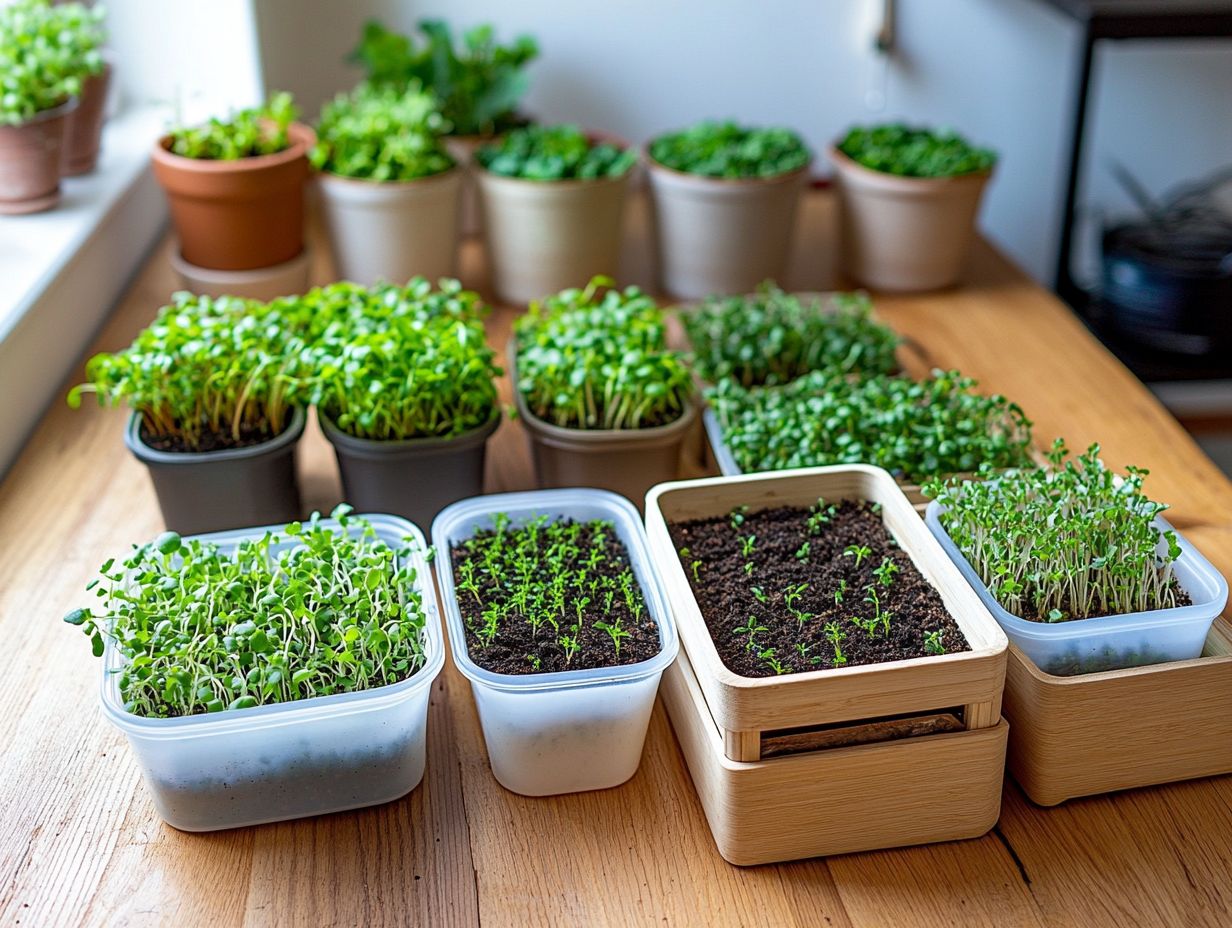
The size and material of your containers play a pivotal role in the successful growth of microgreens. These containers come in various sizes, from small seedling trays to larger flats, allowing you to select the perfect fit for your specific crop types.
With a variety of packaging types available, think clamshells and eco-friendly options crafted from sustainable materials, you have the power to elevate your microgreens business. Opting for biodegradable choices can significantly enhance your appeal, especially since consumers are increasingly drawn to environmentally responsible products. Additionally, understanding how to maximize yields from microgreens can further improve your business success.
Materials like recycled plastics and bamboo compostables not only promote sustainability but also help maintain the moisture levels crucial for optimal growth. As consumers become more mindful of their purchasing choices, they tend to favor brands that prioritize eco-friendly packaging solutions.
This growing trend encourages you to adopt sustainable practices! Embracing these practices will foster increased customer loyalty and satisfaction.
Drainage and Aeration
Proper drainage and aeration are crucial elements in your container design for growing microgreens, as they significantly influence the health of your soil mix and the effectiveness of your watering techniques. By choosing growth trays with efficient drainage systems, you can prevent overwatering and encourage the optimal development of your microgreens a key consideration for any home gardener.
Understanding soil composition is essential for creating a healthy space for growth. A balanced soil mix, enriched with organic matter, ensures that your roots receive both the nutrients and air pockets they need to flourish.
Adopting efficient watering techniques, such as bottom watering (watering from the bottom of the container to keep soil moist without soaking it) or using a spray bottle, can enhance moisture retention while steering clear of soil saturation. This gentle approach not only delivers water directly to the roots but also maintains adequate aeration, ultimately resulting in lush, healthy microgreens thriving in your container. For those interested in maximizing their growth potential, learning how to use hydroponics for microgreens can be incredibly beneficial.
Availability and Cost
The availability and cost of containers can greatly influence your decisions as a microgreens grower. Make careful market research essential to ensure your packaging budget aligns with consumer preferences. By grasping the dynamics of packaging costs and identifying reliable suppliers, you can optimize your operations while catering to your diverse customer base.
Delving into market trends can uncover innovative packaging solutions that not only cut expenses but also elevate your product’s appeal. This strategic approach gives you the power to make informed choices regarding materials, including eco-friendly options that resonate with environmentally-conscious consumers.
Ultimately, these decisions are pivotal in establishing a competitive edge, as they directly impact shelf life, branding, and customer satisfaction. Prioritizing cost-effectiveness and market preferences sets the stage for growth.
Types of Containers for Microgreens
You ll encounter a variety of containers for growing microgreens, each offering distinct advantages. Among them are:
- Specialized microgreen containers: Designed specifically for growing microgreens.
- Recycled options: Made from recycled materials to promote sustainability.
- Growth trays: Used for efficient growth and easy handling.
- Clamshells: Popular for their convenience and visibility.
all designed to create optimal growth conditions while appealing to environmentally conscious consumers. Grasping the benefits of each packaging type is crucial for maximizing product freshness and ensuring consumer satisfaction. For those interested in maximizing space, check out this guide on how to grow microgreens in a small space.
Start exploring your container options today!
Trays and Pots
Trays and pots are among your best options for growing microgreens. Each offers distinct advantages that enhance your experience. Growth trays maximize yields, while pots add visual flair and variety to your display.
Trays truly shine in usability by maximizing planting area. This allows you to cultivate multiple varieties at once, which is especially beneficial for commercial growers looking to boost productivity. If you’re a beginner interested in this method, consider checking out how to start a microgreen garden for beginners. In contrast, pots provide versatility and can be arranged to create appealing presentations, giving you more flexibility in showcasing your products.
While trays create a more efficient growth environment, they can sometimes present a uniform look that doesn’t excite consumers. On the other hand, the unique shapes and vibrant colors of pots visually captivate customers, drawing them to specific products and enhancing their overall shopping experience.
Ultimately, your choice between trays and pots depends on balancing practicality with your desire to create an inviting, memorable display that resonates with your audience.
Recycled Containers
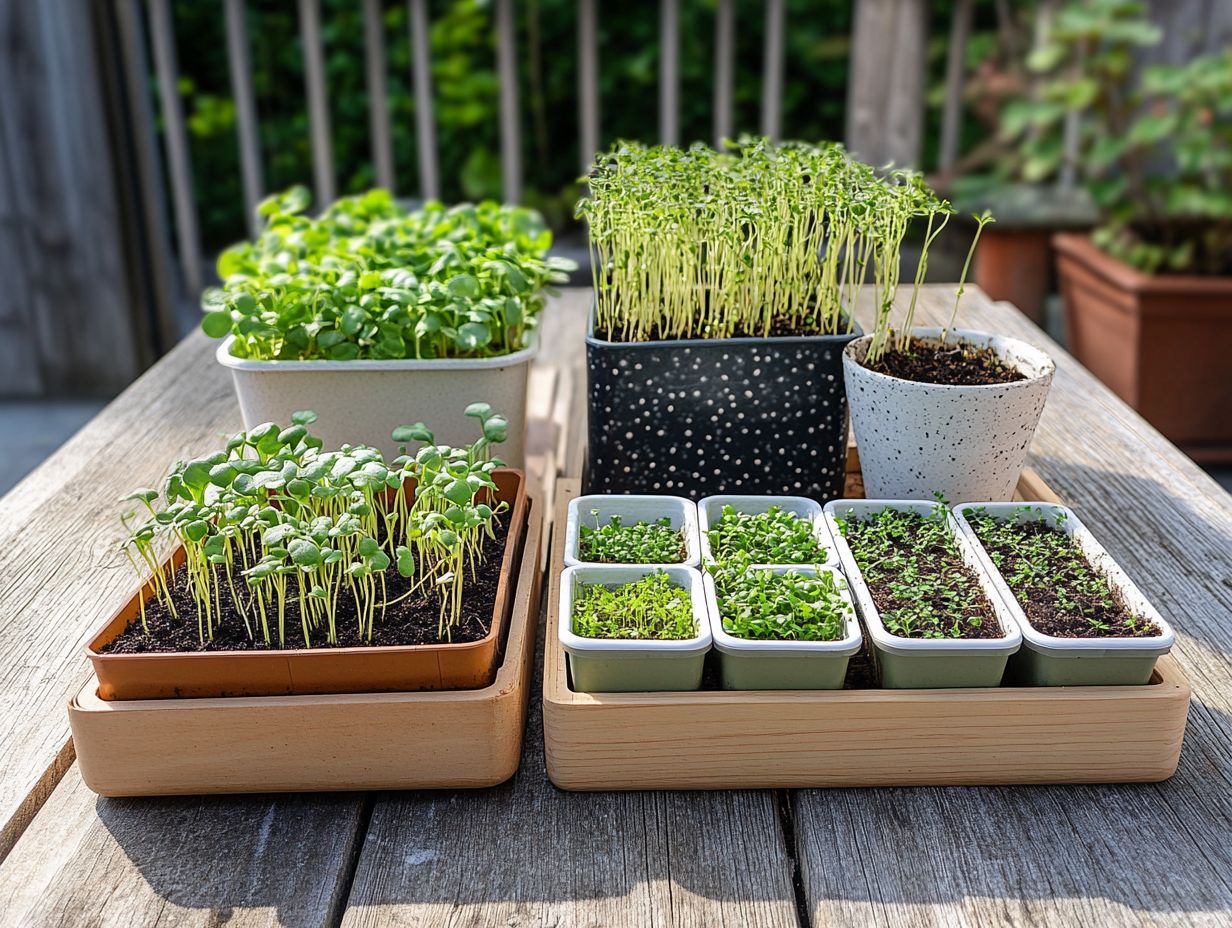
Recycled containers stand out as a premium choice for growers eager to adopt eco-friendly packaging solutions. By choosing these containers, you re not just reducing waste; you re aligning your brand with sustainable practices that today s environmentally conscious consumers prefer. This enhances the overall design and appeal of your microgreens business.
When you opt for recycled materials, you significantly decrease your carbon footprint and tap into a market that genuinely values sustainability. With growing consumer awareness about environmental issues, these thoughtful choices can boost brand loyalty and attract new customers eager to support eco-conscious efforts.
Incorporating biodegradable packaging into your eco-friendly strategy amplifies the marketability of your products. This approach not only addresses the urgent need to reduce plastic waste but also emphasizes your commitment to long-term environmental stewardship. Join the eco-friendly movement today!
Specialized Microgreen Containers
Specialized microgreen containers are designed with your unique needs in mind. They ensure optimal growth conditions and support effective watering methods. These containers boast tailored specifications that enhance product identity and engage customers with attractive designs.
Enjoy features such as drainage holes, breathable materials, and stackable designs. These features promote healthier root development and streamline your gardening experience, whether you’re a novice or a seasoned cultivator. For those looking to enhance their skills, learning how to use a grow tent for microgreens can be particularly beneficial.
With an efficient growing environment, these thoughtfully designed containers encourage you to explore various microgreens, broadening your cooking possibilities. Additionally, for those interested in starting their own microgreen journey, a step-by-step guide to sowing microgreens can be invaluable. This attention to detail fosters a community of passionate growers eager to share their experiences, further enhancing your brand’s reputation in the market.
Best Practices for Growing Microgreens in Containers
Implementing best practices for cultivating microgreens in containers is essential for achieving healthy growth and maximizing yields. Focus on effective planting methods and precise watering techniques that meet the nutritional needs of the plants.
Follow these guidelines to wow your customers with fresher, tastier microgreens!
Preparing the Container
Preparing your container correctly is a foundational step in growing microgreens. It all starts with the right soil mix. You ll want to ensure proper drainage and aeration to create that ideal growth environment. Implementing effective watering techniques during this preparation phase can significantly influence your success, ultimately impacting the quality of your final product.
- First, picking a soil mix specifically designed for microgreens is essential. Look for something lightweight and nutrient-rich to promote healthy root development.
- Establishing adequate drainage is crucial; without it, excessive water can lead to root rot, severely hindering your microgreens growth.
- Aeration is equally important. It allows oxygen to reach the roots, ensuring optimal nutrient absorption and overall plant health.
By focusing on these details, you can create a nurturing environment where your microgreens thrive, yielding vibrant and flavorful results in no time.
Planting and Maintenance Tips
Utilizing effective planting techniques and maintenance tips is essential for your success in growing microgreens. Ensuring they receive adequate nutrients and hydration throughout their lifecycle will set you up for flavorful and nutrient-rich results. By implementing optimal watering techniques and nutrient solutions, you ll create a thriving environment that encourages robust growth.
- First, choose the right substrate (the base material for your plants) that retains moisture yet allows for proper drainage to prevent mold.
- During the initial germination phase, gentle misting is your best friend. It keeps the soil consistently damp without risking waterlogging.
- As your microgreens transition to the growth phase, you’ll want to adjust the watering frequency to meet their increasing moisture needs, which will support their development.
In the later stages, incorporating nutrient solutions, such as a balanced liquid fertilizer diluted to a quarter strength, can significantly enhance their growth. Additionally, knowing how to choose the right soil for microgreen growth allows those delicate greens to absorb the essential minerals they need to flourish.
Choosing the Right Container for Your Microgreens

Selecting the right container for your microgreens is a pivotal choice that significantly impacts growth outcomes and resonates with consumer preferences, ultimately enriching the customer experience. Consider factors like packaging design, material selection, and the functionality of growth trays to ensure both your plants and your customers flourish.
Focusing on sustainability in your container choices can deeply appeal to eco-conscious customers, heightening their likelihood of selecting products that align with their values. Aesthetic elements such as colour and branding are crucial for capturing attention on the shelves. Ensuring ease of use can elevate overall consumer satisfaction.
In the end, a well-designed container transcends mere functionality; it becomes a powerful storytelling tool that allows your brand to connect with its audience and cultivate loyalty. This connection, in turn, fuels sustained business growth.
Frequently Asked Questions
What factors should I consider when choosing a container for microgreens?
When choosing a container for microgreens, consider the size, material, drainage, and ventilation. These factors will affect the growth and health of your microgreens.
What size container is best for growing microgreens?
The size of the container you choose will depend on the type of microgreens you are growing. Generally, a container with a depth of at least 2-3 inches will provide enough space for the roots to grow and allow for proper drainage.
What materials are best for microgreen containers?
Materials such as plastic, ceramic, or clay are commonly used for microgreen containers. Plastic containers are lightweight and drain well. Avoid metal as it can harm growth.
Do I need special drainage holes in my container for microgreens?
Yes, proper drainage is essential for microgreens as they are prone to root rot if the soil becomes waterlogged. Make sure your container has adequate drainage holes to allow excess water to drain out.
Ready to start your microgreens journey? Get your supplies today and watch your greens flourish!
Do I need to provide ventilation for my microgreens?
Yes, microgreens need proper ventilation to stop mold and bacteria from growing.
Choose containers with holes or slits, or leave the lid slightly open on covered containers.
Can I reuse containers for growing microgreens?
You can reuse containers for microgreens.
Just clean and disinfect them thoroughly before each use to avoid spreading diseases or pests.

